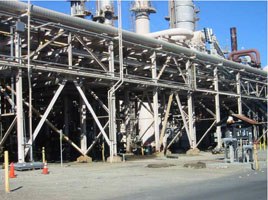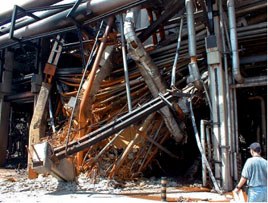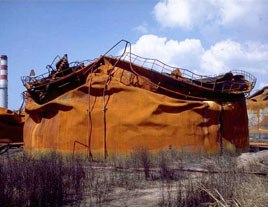Structural Safety of Industrial Steel Tanks, Pressure Vessels and Piping Systems Under Seismic Loading
A European RFCS research program
July 2009 - December 2012
INDUSE
Home | Project Description | Partners | Work Packages | Links | Contact
The INDUSE project is aimed at developing design guidelines/recommendations for safeguarding structural integrity of industrial equipment steel structures, namely industrial tanks, pressure vessels and piping, under strong seismic action. The work combines structural seismic engineering concepts with mechanical engineering practice, considering the particularities of industrial systems and their support structures (shape and geometry, high internal pressure, interaction with liquid containment and the supporting structural system, material defects and damages that reduce significantly deformation capacity).
The final objective is the development of a complete set of design guidelines/recommendations, for the seismic analysis and design of industrial tanks, pressure vessels and piping, compatible with the Eurocode 8 (EN 1998) seismic design framework and, in particular, with the existing EN 1998-4 seismic provisions for liquid storage tanks. The guidelines will be novel and unique, incorporating modern aspects of earthquake-resistant design and are aimed at:
-
•expanding EN 1998-4 provisions towards an integrated seismic design of liquid storage tanks and attached equipment, incorporating some special features and all possible failure modes (WP5)
-
-
•extending the applicability of Eurocode 8 (EN 1998) concepts for the cases of industrial pressure vessels and attached equipment (WP6), and piping systems including their support systems (WP7).
To achieve this purpose, the following intermediate goals are targeted within the INDUSE project:
-
•A basic comparison will be performed between the currently available seismic design provisions in European and American standards (WP1), considering specific design examples; furthermore, an assessment of seismic damages in industrial facilities will be conducted.
-
•Taking account the dynamic behaviour of each structural system, and its interactions with enclosed liquid and its flexible supports, seismic actions on those industrial systems will be determined (WP2). This will define appropriate loading ranges, towards better preparation of experiments.
-
•The structural behaviour of key structural components will be investigated. Strong cyclic (static and pseudo-dymanic) loading test (WP3) will be conducted on critical components (e.g. nozzles, pipe connections and elbows).
-
•Finally, numerical studies on these components will also be conducted, based on extensive FE analyses, covering a wide range of geometric, material and loading parameters (WP4).
The INDUSE project consists of three major parts (phases). Phase I of the project consists of a comparison between existing methodologies for seismic design and collection/evaluation of available relevant test data, as well as the analysis of tanks, vessels and piping as structural systems. Phase II focuses on component behaviour, through experimental work, supported by nonlinear finite element simulations. Finally, Phase III refers to the development of the design guidelines/recommendations, which is the main objective of the project.




Damages in industrial facilities
during the Kocaeli 1999 eartquake, Turkey